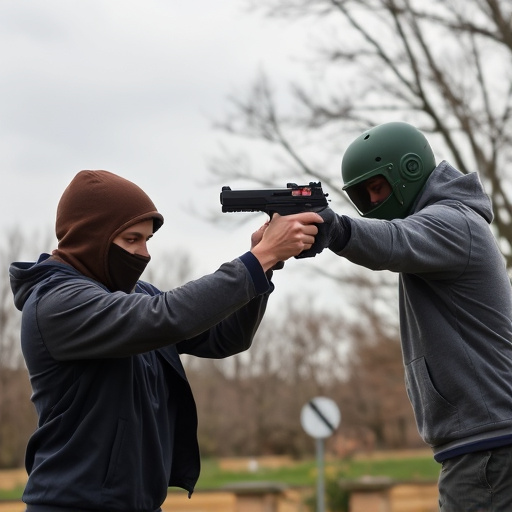Pepper spray training for beginners is essential for safe and effective use, covering handling, safety, deployment strategies, and legal frameworks. Choosing the right dispenser from reputable brands with precise spray patterns enhances learning outcomes. Training includes mechanics understanding, practical exercises, de-escalation scenarios, and regular practice sessions. In riot control, pepper spray is a vital tool for civil unrest management, used by law enforcement, security, and citizens after proper training in strategic deployment and continuous preparation.
Discover the power of pepper spray as a riot control tool with our comprehensive guide. From understanding its basics to mastering effective training techniques, this article equips beginners with vital knowledge. Learn about legal frameworks governing force usage and essential features to consider when choosing a spray dispenser. Explore real-world applications in riot control strategies, ensuring you’re prepared for dynamic situations. Dive into the world of pepper spray training for beginners and gain insights that could save lives.
- Understanding Pepper Spray: Basics for Beginners
- Legal Considerations and Use of Force
- Choosing the Right Equipment: Spray Dispenser Features
- Effective Pepper Spray Training Techniques
- Real-World Applications: Riot Control Strategies
Understanding Pepper Spray: Basics for Beginners
Pepper spray, officially known as oleoresin capsicum (OC) spray, is a non-lethal self-defense tool that has gained widespread popularity for riot control and personal safety. It works by irritating the eyes and respiratory system, causing temporary disorientation and immobilization. For beginners considering pepper spray as a means of protection, understanding its basics is crucial.
Pepper spray training for beginners involves learning proper handling techniques, safety precautions, and effective deployment strategies. It’s essential to know that different types of pepper spray have varying levels of capsaicin concentration, determining their range, duration, and impact. Training should also cover how to avoid cross-contamination, store the spray safely, and handle potential side effects, ensuring users are prepared for any situation they might encounter while using this powerful tool.
Legal Considerations and Use of Force
When it comes to using inflammatory riot control spray, legal considerations and the appropriate use of force are paramount. In many jurisdictions, pepper spray—a type of inflammatory riot control agent—is regulated under specific laws and guidelines governing the use of force by law enforcement and security personnel. Officers are required to undergo rigorous Pepper Spray Training for Beginners to understand when, how, and why to deploy such a powerful tool. This training emphasizes the importance of de-escalation techniques first, only resorting to pepper spray as a last resort when necessary to control or disperse an active threat.
The use of force, including inflammatory riot control sprays, must be proportional to the perceived danger. Excessive or unnecessary use can lead to serious injuries and potential legal repercussions. Therefore, officers are trained to assess each situation critically, considering factors such as the number of individuals involved, their behavior, and any potential for harm to bystanders. Regular reviews and updates of Pepper Spray Training programs ensure that law enforcement stays current with best practices, ensuring both public safety and accountability in the use of force.
Choosing the Right Equipment: Spray Dispenser Features
When it comes to equipping yourself for pepper spray training, beginners should pay close attention to the features of their chosen spray dispenser. Not all models are created equal, and understanding these differences is crucial for effective self-defense. Look for a reliable brand that offers a balance between power, accuracy, and ease of use. The spray pattern should be designed to cover a wide area while ensuring droplets land precisely on the target, maximizing impact without wasting valuable product.
Additionally, consider the size and weight of the dispenser. A smaller, lighter device might be more manageable for beginners, allowing them to practice proper technique without feeling cumbersome or heavy-handed. Remember, the right equipment can significantly enhance learning outcomes during pepper spray training for beginners, ensuring both safety and effectiveness in real-world scenarios.
Effective Pepper Spray Training Techniques
For individuals new to pepper spray, proper training is paramount. Pepper spray training for beginners should start with understanding the device’s mechanics and safety features. Familiarize yourself with the trigger mechanism, target areas, and range – knowledge that ensures safe and effective usage. Practical exercises in a controlled environment are crucial. Begin with simulated scenarios where you learn to accurately aim and deploy the spray at different distances.
Beyond basic handling, advanced training techniques should focus on de-escalation strategies. Role-playing scenarios can help beginners learn to assess situations, communicate effectively, and only resort to pepper spray as a last resort. Regular practice sessions are essential for muscle memory, enabling users to respond quickly and confidently in high-stress environments.
Real-World Applications: Riot Control Strategies
In real-world scenarios, riot control strategies often involve a combination of non-lethal and lethal force, with pepper spray playing a significant role in de-escalating high-tension situations. Pepper spray training for beginners is crucial as it equips individuals with essential skills to manage civil unrest effectively. It’s used not only by law enforcement but also by private security and citizens looking to protect themselves in chaotic environments.
Riot control officers employ various techniques, such as line formations and tactical positioning, coupled with pepper spray deployment, to maintain order. The strategic use of this chemical agent can disrupt rioters’ ability to coordinate and sustain violence, allowing for a safer resolution of the crisis. Effective riot control strategies require thorough planning, proper equipment, and continuous training, including regular practice in simulated scenarios to ensure preparedness and proficiency.
Pepper spray, a powerful tool in riot control and personal defense, can be an effective solution when used appropriately. By understanding its basics, learning legal boundaries, and investing in quality equipment like advanced spray dispenser models, individuals and law enforcement agencies alike can ensure safe and strategic deployment. Effective pepper spray training for beginners is paramount to responsible use, enabling folks to navigate challenging situations with confidence and control.
